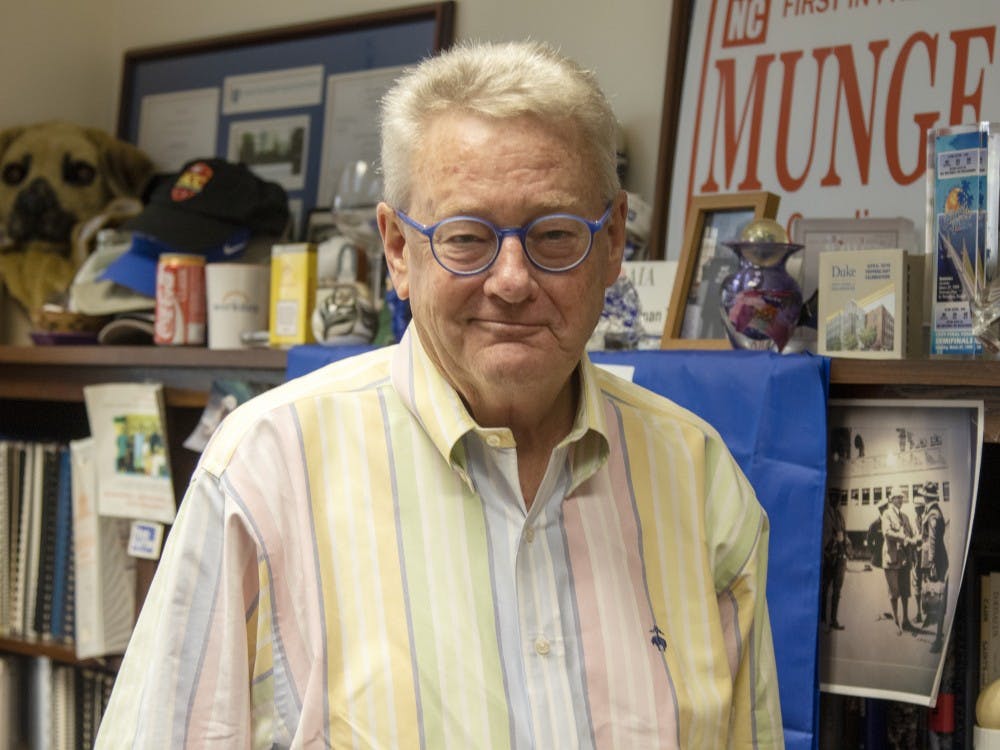After more than 20 years with the University, Executive Vice President Tallman Trask will retire in fall 2020.
The University announced the departure in a news release Friday morning. Trask has served as Duke’s EVP since 1995, working for three different presidents—Nannerl Keohane, Richard Brodhead and current President Vincent Price. During his time as EVP, he has overseen dozens of construction projects, including renovations to the Bryan Center Plaza, Brodhead Center and Wallace Wade, and has helped the endowment grow from $790 million to $8.6 billion.
He directs the University’s construction, campus planning, finances, administration and other services like Duke parking and stores. He is on the Board of Directors for the Duke University Management Company—which manages the University’s endowment—and the Health System.
As chief fiscal officer, he helped guide the University through the aftermath of the Great Recession of 2008. Trask also expanded Duke’s off campus presence into Durham, as the city has seen tremendous growth in the past two decades.
His tenure has not come without controversy, however. The Chronicle reported in 2016 that he hit a parking attendant with his car two years prior. He was also accused of calling her a racial slur, which he denied. Trask was also Duke’s lead negotiator for the light rail project that it pulled out of earlier this year.
His time on campus
Taking in his whole body of work throughout the past quarter-century, Trask said he is pleased with his work at the University.
“I'm quite happy with it,” Trask said in his heavily decorated office, with his signature T3 moniker stitched onto his shirt cuffs. “I mean, look, in 25 years, there's been hundreds of little things you'd do differently. But in general, I'm not troubled by it.”
Trask led the recent overhaul of the BC Plaza area—now known as the Campus Center—which was designed to be the center of student life. The project featured the new Health and Wellness Center, Penn Pavilion and elevated walkway, as well as restorations for Page Auditorium. Most notably, West Union—now the Brodhead Center—was rebuilt for $95 million into the glass-walled dining hub students know today.
The birth of the Campus Center coincided with other construction in the last five years, as Trask oversaw renovations to the Chapel, Wallace Wade Stadium and Baldwin Auditorium and the building of the Rubenstein Arts Center.
Additionally, three residence halls have been built since 1995: The West-Edens Link (now Keohane Quad) in Fall 2002, Trinity Dorm on East Campus in 2017 and Hollows Quad in August. Numerous others have been modernized, including Craven and Crowell Quads and Southgate Dorm in the past few years.
In 2003, the American Institute of Architects elected him as an honorary member.
“Tallman will rightfully be remembered at Duke for his steady transformation of our campus, as he delivered a modern, indeed spectacular physical plant that better promotes the health and well-being of all who work and live here,” President Vincent Price said in a news release.
Trask helped navigate Duke through the Great Recession, when the University endowment fell by 25% and Duke had to postpone or cancel major projects. He made spending cuts and helped to keep Duke afloat during the crisis.
He told Duke Student Government Senate in February 2009 that the University was running a deficit of around $130 million. By March, the endowment—which supports Duke’s budget, especially for financial aid, faculty salaries and other services—was down from $6 billion to $4 billion, and Duke was looking to save money.
Trask explained to The Chronicle in 2009 that he prioritized maintaining academic funding levels while focusing on administrative spending cuts so that faculty and students didn’t have to suffer too many consequences. He stuck with the University throughout the past decade until it could orchestrate a construction boom and close down Central Campus this year.
Trask pushed Duke to invest in Durham as well. The University donated $7.5 million to help Durham construct the $46.8 million Durham Performing Arts Center (DPAC). It has also placed hundreds of employees in offices downtown during the last two decades. By renting out thousands of square feet in the American Tobacco District and other downtown properties, Duke helped attract investors to the area.
“We wanted Duke to be a ‘credit-worthy client’ and did not want downtown Durham to be downtown Duke," Bill Kalkhof, the inaugural president of Downtown Durham Inc., said in 2014. "By Duke not owning the property, the property stayed on the tax forms for Durham. Duke stepped up to the plate in a very big way at a critical time."
But last year, the Durham-Orange Light Rail Transit Project came to a halt when Duke would not agree to sign a cooperation agreement. The project became a major point of contention between Duke and Durham. Duke—with Trask as its main liaison—and regional officials spent 20 years negotiating a light rail connecting Durham and Chapel Hill.
When Duke decided to not sign a cooperation agreement to donate land by its medical center to GoTriangle, the regional transit authority, in February 2019, the University effectively put the final nail in the coffin for the light rail.
Get The Chronicle straight to your inbox
Sign up for our weekly newsletter. Cancel at any time.
His biggest controversy came in February 2016, when The Chronicle reported that Trask hit parking attendant Shelvia Underwood with his Porsche before a football game in 2014. Underwood accused Trask of calling her a “stupid n******” as he drove off, which he denied. She filed a lawsuit in March 2016 against Trask and Duke, alleging battery, negligence, civil conspiracy and obstruction of justice, which was dismissed in 2017 after an insurance settlement.
Beware the lollipop of mediocrity
In 1994, Duke was not on Trask’s radar. The third-generation Los Angeles native had lived most of his life on the West Coast, and he was at the time the executive vice president of the University of Washington, another research institution with close ties to its hospital.
“I had no interest in coming to Duke,” he told The Chronicle in October. “If you'd asked me six weeks before I came here, ‘What are the odds you would move to North Carolina?’ I would have asked you if they could possibly be below zero.”
But then Keohane, who was Duke’s president at the time, called. After careful consideration, he decided to move across the country to Duke.
"We knew that Tallman Trask would make a good addition to our senior administration.... He has more than fulfilled our high expectations," Keohane told The Chronicle after Trask’s first year.
Today, his office is filled with tokens from nearly 25 years at Duke. He has blueprints and architectural drawings crammed top-to-bottom on a shelf. Various references to “T3” adorn the office, as well as a bust of Mao Zedong, a Grumpy doll from Snow White and a cardboard cutout of himself given to him by his UW colleagues. On a bookshelf, a little poster reads “Beware the lollipop of mediocrity—lick it once and you suck forever.”
In the release, Price praised Trask for his investments in financial aid, Durham and the environment throughout his years as EVP.
“Tallman has also provided invaluable mentorship and leadership to an entire generation of Duke employees,” he said. “We are so very grateful for his service.”
Editor's note: Do you have a reaction to Trask's retirement announcement? Let us know by filling out the form below. Your reaction could be featured in a subsequent article.
By filling out this form, you agree to have your name published in a future article by The Chronicle:

Jake Satisky was the Editor-in-Chief for Volume 115 of The Chronicle.

